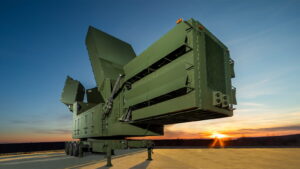RTX [RTX] and the Army recently completed the second successful live-fire demonstration of the Lower Tier Air and Missile Defense Sensor (LTAMDS), this time against a tactical ballistic missile.
This is the second live-fire test in a series of developmental test for LTAMDS as it prepares to become the new radar for the Army Patriot air defense system.

This follows a similar live-fire test against a cruise missile-type target in November. Both tests occurred at White Sands Missile Range, N.M. (Defense Daily, Nov. 20).
The latest test maintained the same sequence of events and systems as the first, except with a different target. Here the Army launched an unspecified “tactical ballistic missile surrogate” on a threat-representative trajectory.
LTAMDS acquired and tracked the target, then the data was passed on to the Integrated Battle Command System (IBCS) for launch command. LTAMDS then guided a Patriot Advanced Capability-3 (PAC-3) Cost Reduction Initiative (CRI) missile to intercept the target.
“With each test, we’re putting the radar up against realistic threats that our forces could face on the battlefield. And with each success, we see capability improvement for this transformational radar,” U.S. Army Col. Jason Tate, Search, Track, Acquire, Radiate, Eliminate (STARE) Project Manager for Program Executive Office Missiles and Space, said in a statement.
“From the start, the goal was to design a next-generation radar capable of outpacing the full range of current and future threats – and we will achieve that goal with LTAMDS,” he continued.
LTAMDS is a 360-degree Active Electronically Scanned Array radar using Gallium Nitride that is billed as providing improved performance over the legacy Patriot radar against manned and unmanned aircraft, cruise missile, ballistic missiles and hypersonic missiles.
In October, RTX said LTAMDS is set to reach initial operational capability by the end of the year and full operational capability (FOC) in 2024 (Defense Daily, Oct. 5).
RTX reiterated this testing follows contractor verification tests and more test events will continue through the end of this year and into 2024 before FOC.
The company has finished production on all six LTAMDS radar units contracted in 2019, with all of them undergoing testing.